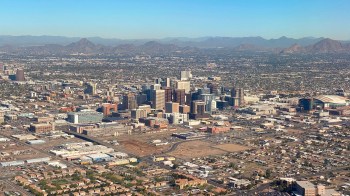TEXT OF STORY
Kai Ryssdal: 308,754,538. That’s how many Americans there are. I suppose technically you could call it a lagging indicator, since the official date for the census was this past April 1st, but it takes a while to sort through the data. And that’s what people have been doing all day, mostly to talk about the politics of it: which states gained population — and so will get more representation in the House — and which states will lose.
But the data is really people. Workers and consumers, potential homeowners and future retirees. So we asked Marketplace’s Mitchell Hartman what the numbers says about them and their economy.
Mitchell Hartman: The U.S. population rose by nearly 10 percent in the last decade. But that was actually the slowest growth since the Great Depression.
And for that, you can thank the Great Recession. A bad economy has kept the birth rate and immigration down. Early in the decade, population was also shifting a lot, with millions of people moving from the Rustbelt to the Sunbelt in search of jobs or a cozy retirement.
Kenneth Johnson: These trends might have been more pronounced had it not been for the recession.
Kenneth Johnson is a demographer at the University of New Hampshire.
Johnson: Domestic migration — people moving from one place in the United States to another — really slowed down considerably in the last couple of years.
So, although Sunbelt states gained population, they probably would have gained even more if their housing and job markets hadn’t crashed so hard.
Johnson: The economies in Arizona, Nevada or Florida are very dependent on growth itself.
Texas bucked the trend, though. Economist Ray Perryman leads a forecasting firm in Waco.
Ray Perryman: Texas did better than most states during the recession, and we did continue to receive some in-migration during the recession, it slowed down some but it continued at a pretty good pace, which is about 1,100 people a day. So it’s a remarkable amount of economic growth.
Across the South, a big chunk of the increased population is Hispanic — both immigrants and their U.S.-born children.
Perryman: Which again brings infrastructure challenges and education challenges and other things, but also gives us a young workforce, in some cases a very well-talented and trained workforce, and that’s been something that’s given us a competitive edge.
Because the Hispanic population is young, it’s poised to spend heavily in coming years on higher education, first homes, and all the consumer goods needed to fill them.
I’m Mitchell Hartman for Marketplace.
There’s a lot happening in the world. Through it all, Marketplace is here for you.
You rely on Marketplace to break down the world’s events and tell you how it affects you in a fact-based, approachable way. We rely on your financial support to keep making that possible.
Your donation today powers the independent journalism that you rely on. For just $5/month, you can help sustain Marketplace so we can keep reporting on the things that matter to you.


















